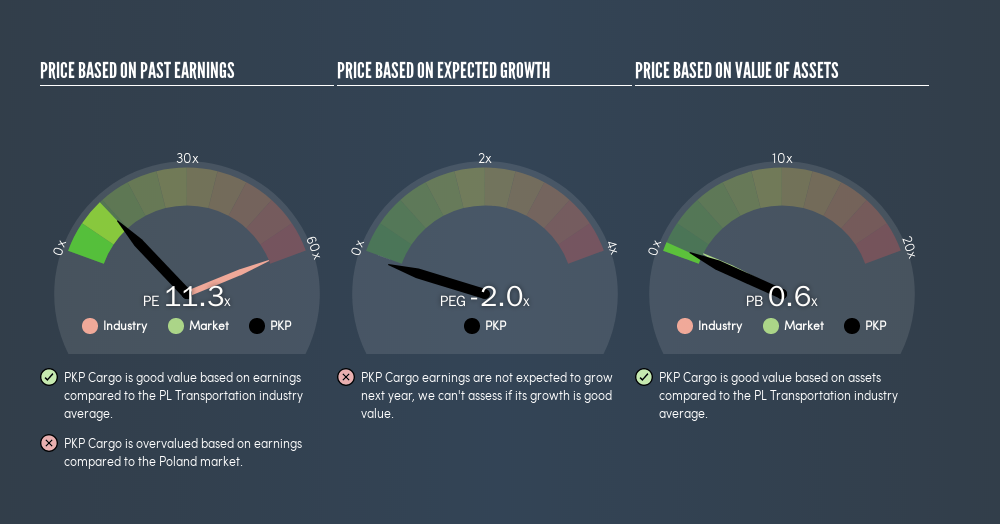
This article is written for those who want to get better at using price to earnings ratios (P/E ratios). To keep it practical, we'll show how PKP Cargo S.A.'s (WSE:PKP) P/E ratio could help you assess the value on offer. PKP Cargo has a P/E ratio of 11.35, based on the last twelve months. That is equivalent to an earnings yield of about 8.8%.
Check out our latest analysis for PKP Cargo
How Do I Calculate A Price To Earnings Ratio?
The formula for price to earnings is:
Price to Earnings Ratio = Share Price ÷ Earnings per Share (EPS)
Or for PKP Cargo:
P/E of 11.35 = PLN46.6 ÷ PLN4.11 (Based on the year to December 2018.)
Is A High P/E Ratio Good?
A higher P/E ratio means that investors are paying a higher price for each PLN1 of company earnings. All else being equal, it's better to pay a low price -- but as Warren Buffett said, 'It's far better to buy a wonderful company at a fair price than a fair company at a wonderful price.'
How Growth Rates Impact P/E Ratios
P/E ratios primarily reflect market expectations around earnings growth rates. That's because companies that grow earnings per share quickly will rapidly increase the 'E' in the equation. That means even if the current P/E is high, it will reduce over time if the share price stays flat. And as that P/E ratio drops, the company will look cheap, unless its share price increases.
In the last year, PKP Cargo grew EPS like Taylor Swift grew her fan base back in 2010; the 125% gain was both fast and well deserved. The cherry on top is that the five year growth rate was an impressive 19% per year. With that kind of growth rate we would generally expect a high P/E ratio.
Does PKP Cargo Have A Relatively High Or Low P/E For Its Industry?
The P/E ratio essentially measures market expectations of a company. If you look at the image below, you can see PKP Cargo has a lower P/E than the average (59) in the transportation industry classification.

This suggests that market participants think PKP Cargo will underperform other companies in its industry. Many investors like to buy stocks when the market is pessimistic about their prospects. If you consider the stock interesting, further research is recommended. For example, I often monitor director buying and selling.
A Limitation: P/E Ratios Ignore Debt and Cash In The Bank
Don't forget that the P/E ratio considers market capitalization. In other words, it does not consider any debt or cash that the company may have on the balance sheet. In theory, a company can lower its future P/E ratio by using cash or debt to invest in growth.
Such expenditure might be good or bad, in the long term, but the point here is that the balance sheet is not reflected by this ratio.
So What Does PKP Cargo's Balance Sheet Tell Us?
PKP Cargo's net debt equates to 37% of its market capitalization. While that's enough to warrant consideration, it doesn't really concern us.
The Verdict On PKP Cargo's P/E Ratio
PKP Cargo's P/E is 11.3 which is about average (11.3) in the PL market. Given it has reasonable debt levels, and grew earnings strongly last year, the P/E indicates the market has doubts this growth can be sustained. Since analysts are predicting growth will continue, one might expect to see a higher P/E so it may be worth looking closer.
Investors should be looking to buy stocks that the market is wrong about. If the reality for a company is better than it expects, you can make money by buying and holding for the long term. So this freereport on the analyst consensus forecasts could help you make a master move on this stock.
Of course you might be able to find a better stock than PKP Cargo. So you may wish to see this freecollection of other companies that have grown earnings strongly.
We aim to bring you long-term focused research analysis driven by fundamental data. Note that our analysis may not factor in the latest price-sensitive company announcements or qualitative material.
If you spot an error that warrants correction, please contact the editor at editorial-team@simplywallst.com. This article by Simply Wall St is general in nature. It does not constitute a recommendation to buy or sell any stock, and does not take account of your objectives, or your financial situation. Simply Wall St has no position in the stocks mentioned. Thank you for reading.
About WSE:PKP
Pkp Cargo
Engages in the transport of goods and the provision of logistics services in the field of rail freight in Poland and internationally.
Moderate growth potential with mediocre balance sheet.


